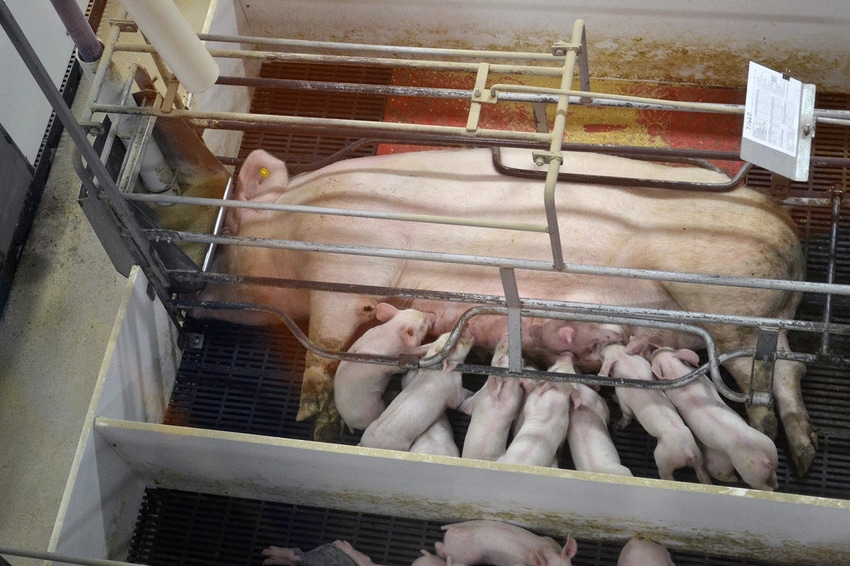Identifying functional teats in swine
Teat size in the nursery, relative to surrounding teats, directly correlates with teat size and function later in life.
October 5, 2023

By Mark Knauer, Zack Peppmeier and Kai Hsiang Lin, North Carolina State University
An additional functional teat on a sow can enhance piglet survival by 2 to 3%. Yet identifying and counting functional teats can be time consuming and somewhat subjective. Hence, the aim of this article is to enhance the ability of farm technicians to identify functional teats.
Through research conducted at the NCDA Tidewater Research Station (Plymouth, North Carolina) we have observed that teat size in the nursery, relative to surrounding teats, directly correlates with teat size and function later in life. In fact, it is perhaps easier to identify substandard teats (<70% the size of the surrounding teats) at weaning or in the early nursery phase than at six months of age. Why is this? We believe when evaluating underlines at a young age, one can more easily see the relative size of a teat when compared to surrounding teats. Please see Figure 1 for examples of substandard teats identified in the early nursery period.
 Figure 1. Examples of substandard teats (circled, <70% the size of the surrounding teats) at 30 days of age. Substandard teats at 30 days of age remain substandard throughout the female’s life.
Figure 1. Examples of substandard teats (circled, <70% the size of the surrounding teats) at 30 days of age. Substandard teats at 30 days of age remain substandard throughout the female’s life.
Examples of good underlines with uniform teats are shown in Figure 2.
 Figure 2. Examples of uniform underlines at 30 days of age.
Figure 2. Examples of uniform underlines at 30 days of age.
In Figure 3, examples of substandard sow teats are shown. At the genetic, multiplication and commercial levels of production, substandard teats should not be counted as functional teats as they have been reported less likely to have a functional mammary gland at weaning and impair piglet quality at weaning.


Figure 3. Examples of substandard teats (circled, <70% the size of the surrounding teats) in sows. Substandard teats at 30 days of age remain substandard throughout the female’s life.
In review, we believe functional teat number can largely be identified early in life (near weaning). Given the importance of functional teat number in relation to piglet survival, hopefully these pictures can serve as training tools within your production system. We wish to thank the North Carolina Department of Agriculture Tidewater Research Station for their continued collaboration and efforts towards enhancing the sustainability and profitability of North Carolina pig farmers. Questions and comments can be directed to Knauer at [email protected].
References:
Earnhardt-San, A. L., K. A. Gray, and M. T. Knauer. 2023. Genetic parameter estimates for teat and mammary traits in commercial sows. Animals. 13:2400. doi:10.3390/ani13152400
Obermier, D. R., J. T. Howard, K. A. Gray, and M. T. Knauer. 2023. The impact of functional teat number on reproductive throughput in swine. Transl. Anim. Sci. 7(1):txad100. doi:10.1093/tas/txad100
Peppmeier, Z.C., and M. T. Knauer. 2021. Effect of substandard teats on piglet and sow performance. J. Anim. Sci. 99(Supp 1):133-134. doi:10.1093/jas/skab054.225
Speckman, E. C., J. T. Howard, and J. G. Wiegert. 2021. PSI-10 The relationship between litter size and functional teat number at farrowing on litter size at weaning. J. Anim. Sci. 99(Supp 1):223. doi:10.1093/jas/skab054.365
Vande Pol, K. D., R. O. Bautista, A. Olivo, H. Harper, C. M. Shull, C. B. Brown, and M. Ellis. 2021. Effect of rearing cross-fostered piglets in litters of differing size relative to sow functional teat number on preweaning growth and mortality. Transl. Anim. Sci. 5:4. doi:10.1093/tas/txab193
Wiegert, J. G., and M. T. Knauer. 2018. 98 Sow functional teat number impacts colostrum intake and piglet throughput. J. Anim. Sci. 96(Suppl. S2):51-52. doi:10.1093/jas/sky073.096
You May Also Like



